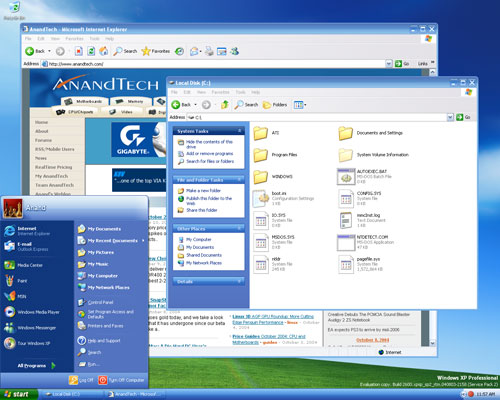
Original Link: https://www.anandtech.com/show/1508
Microsoft Windows XP Media Center Edition 2005: Feature and Performance Investigation
by Anand Lal Shimpi on October 12, 2004 12:19 PM EST- Posted in
- Smartphones
- Mobile
As impressed as we were with Windows XP Media Center Edition when it first launched, it's no surprise that the Microsoft OS has not taken off by storm.
Distributed only to OEMs for use in custom built systems, this wasn't an OS you could go out and buy. Even though some managed to get it (through MSDN and other less legal routes), there were relatively steep hardware requirements keeping that barrier to entry nice and high. You had to have a hardware MPEG-2 encoder card, which at the time of the release of MCE was far from common (since then times have changed, mostly thanks to MCE). You had to have one of the fastest CPUs available on the market, which at the time was around a Pentium 4 3GHz. And you had to have the MCE remote control setup, which also wasn't readily available to end users.
Things have changed however, and while it was still difficult to get a hold of the copy of the OS, the rest of the items became much easier. Places like Newegg began selling the Media Center remote control, with the stipulation that you had to buy it with some sort of hardware to make it look like you were buying a PC with it. And the price of CPUs went down, as the power of CPUs went up. The introduction of the Athlon 64 provided a nice, very powerful, very capable alternative to the Pentium 4 with one very important feature - an on-die memory controller. The on-die memory controller would prove to be very helpful in making the Athlon 64 an extremely high performer when it came to Media Center PCs.
In between MCE's maiden launch and today, Microsoft released a much-needed update to the OS: MCE 2004, which provided bug fixes, performance enhancements and introduced a few new tweaks and features to the OS. But it was clear that MCE 2004 was not an example of perfection, rather an example of the direction Microsoft was going in. There were still numerous features missing from the MCE equation, things like HDTV and multiple tuner support were left unaddressed, only to be serviced in the latest version of Microsoft's Media Center OS - MCE 2005.
Today marks the official launch of MCE 2005 and although there have already been reports on what's new in the updated OS, we've taken an in-depth look at it to not only evaluate the changes made to the OS, but also to finally investigate the performance of the OS and find out how fast of a system you truly need to run this beast of an OS. There are many details within and tons of screenshots, but we strongly suggest that our read our original article on Windows XP Media Center Edition as we will not be rehashing most of the information covered in that article.
Windows XP Media Center Edition: The OS
While most users won't have to install MCE 2005, we did. MCE 2005 is the first Windows XP OS version to ship on two CDs, and yes you need both of them during the installation process. During the installation process you'll have to swap the discs out twice; once to pop disc 2 in, and once to put the first disc back in again.
While all previous versions of the OS were based on Windows XP SP1, Media Center Edition 2005 is built on Service Pack 2, but with a few additions. There's obviously the built in Media Center application, but there is also a new XP theme called Energy Blue, as well as a few new programs that are automatically installed: Windows Audio Converter, Windows CD Label Maker, Windows Dancer and Windows Party Mode.
Windows Audio Converter is a program that will let you convert mp3, wav and wma files into mp3, wma, wma (vbr) or wma lossless formats. The most interesting option is the lossess Windows Media Audio format employs a lossless compression ratio to get the bit rate down as low as possible without actually discarding any of the original audio data.
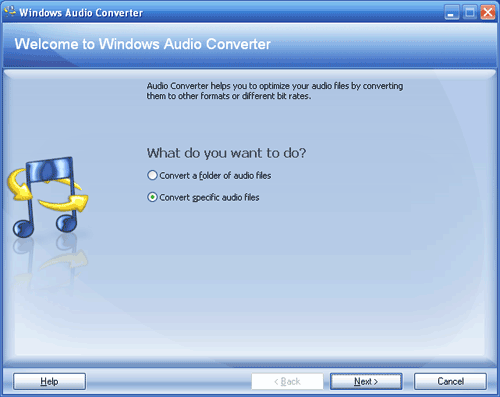
Windows CD Label Maker is pretty straight forward, it is a program that will let you make and print CD Labels, furthering the idea of using your MCE PC as a multipurpose "media center" of your digital life.
Windows Dancer is a program that will cause a little person to dance around on your screen. By default you can set Windows dancer to dance according to the music being played (although MCE 2005 only ships with one dancer, there is an option to automatically choose the dancer based on what type of music is being played). If you really enjoy the dancer you can even turn her loose without any music playing. We didn't like her enough to do that.

The final "Digital Media Enhancement" app that Microsoft ships with MCE 2005 is Windows Party Mode. Windows Party Mode is basically a full screen skin for Windows Media Player 10 that you're supposed to use at parties where everyone can come up and interact with the playlist, choosing what they want to hear next from your WMP10 Library. The skins available are far less polished than what's offered in the actual Media Center UI, but we can see how the feature would be useful in some situations.
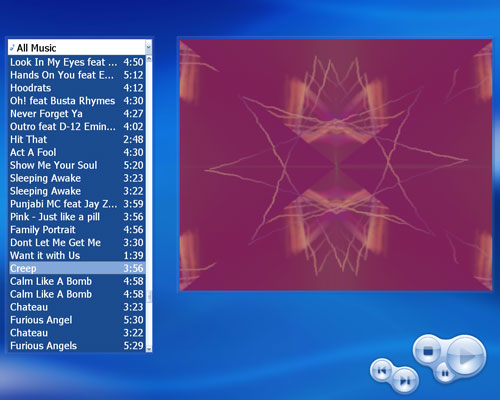
MCE2005 is configurable to start with or without the Media Center interface, by default it is configured not to but changing it isn't a problem. Below we have a screenshot of the new XP theme, Energy Blue:
Launching the Media Center application is the same as before, you either use the green button on the remote or click on the green icon that looks like the aforementioned button. Regardless of which method you choose, the end result is that you're dropped into a fairly familiar interface.

The Media Center interface, My TV is the default selection
A New Setup Tool
With MCE 2005, Microsoft has included a video that helps you adjust your monitor/TV
settings for the best picture quality with Media Center.
Through Media Center's Display Calibration Wizard, you are coached through
adjusting the positioning of your screen, aspect ratio, brightness, contrast
and color balance.

The wizard lets you properly center your screen by displaying a video of a few "friends" playing pool. In a frame within the video there's another video giving you an indication of what you should see on your screen; you adjust what you see on your screen until it matches what's displayed in the box.
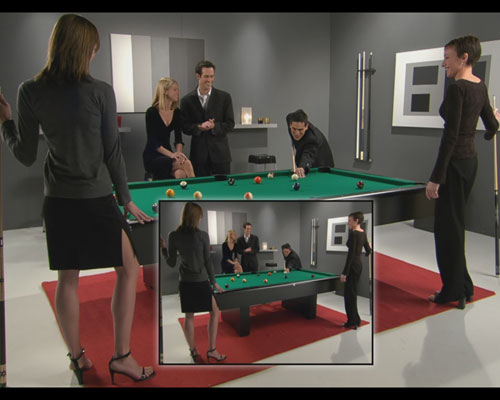
Configuring your aspect ratio is a bit misleading as Media Center tells you to look for the Geometry controls on your display, which aren't exactly related to what you would normally think of when you think aspect ratio (e.g. 4:3 or 16:9 aspect ratios). What the video segment in this clip does do a good job of however is giving you a good reference point to make sure that your display isn't being stretched.

Media Center even tells the user to look to make sure that the cube of chalk looks square and that the billiard balls look round, both things that will be distorted if you are running in a stretched viewing mode. Other than telling you to change your resolution or use the geometry controls on your display, the Display Calibration Wizard does an otherwise poor job of educating the uninformed about how to choose the right aspect ratio setting on their display.
The brightness test is a very useful one and relatively easy to interpret:
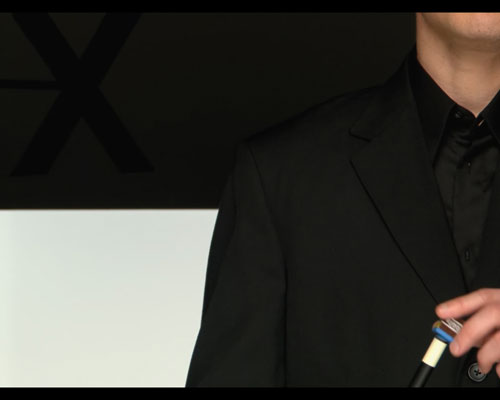
... as is the contrast test:
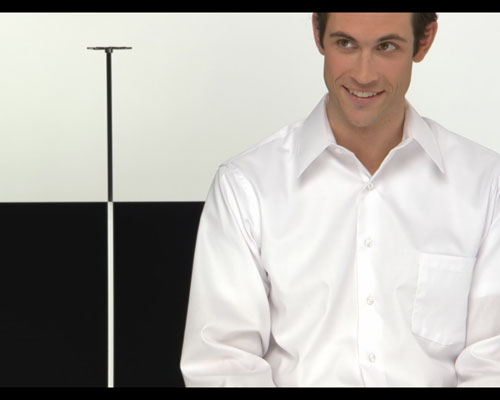
In both situations, the wizard tells the user what to look for and what a properly calibrated display should look like.
Finally the color balance configuration gives you a set of gray bars to remove all red, green or blue tints from.

The Display Calibration Wizard is a nice addition for entry level users as well as those users who are not yet ready to graduate to using something like Video Essentials to configure their display. It's a valiant and appreciated effort on Microsoft's part.
Configuring Windows, 10 Feet Away
What you'll find is that there are a number of Windows control panels and settings that are finally adjustable from within the Media Center UI, which is something that we're quite happy about.
As was the case in past versions of Media Center, the entire setup from configuring your cable TV settings down to downloading program guide updates is completely controllable using just the remote - and you can do it quite well at that.
Media Center 2005 has an audio configuration utility for example that asks you for your speaker configuration, whether you're using a 2 speaker, 5.1 or 7.1 setup. In reality this configuration wizard is simply a Media Center hook into XP's Speaker settings control panel, but it prevents you from having to leave the Media Center UI which provides for a much cleaner user experience.
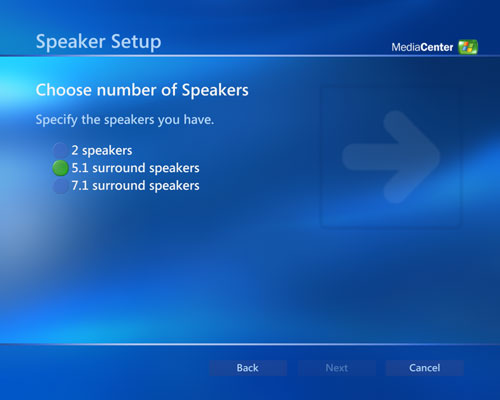
The system isn't entirely perfect yet though, still selecting certain options will cause Windows to want to pop up a regular old XP control panel or IE Window. Thankfully, MCE 2005 at least warns you before you do this and asks if you want to proceed or not. It's getting closer to perfect with every revision, just not quite there yet.
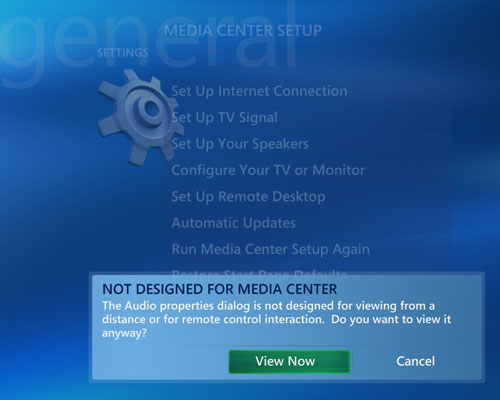
There is even a Remote Desktop Wizard hooked into Media Center now that lets you enable Remote Desktop and even set a password for your Windows account if one isn't already created for remote access - all from the MCE remote; you type in letters using the numeric pad much like you would type a text message on a cell phone.
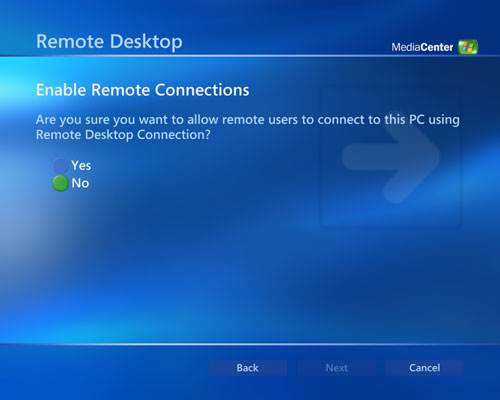
Automatic updates can also be controlled to a certain extent from within the Media Center UI; you can tell Windows to either always automatically update your machine or not to, there are no in-between settings - for those you have to drop out of the Media Center interface.
Hopefully within the next month or so, NVIDIA will have support for adjusting all of your display properties from within the Media Center interface, including things like screen resolution.
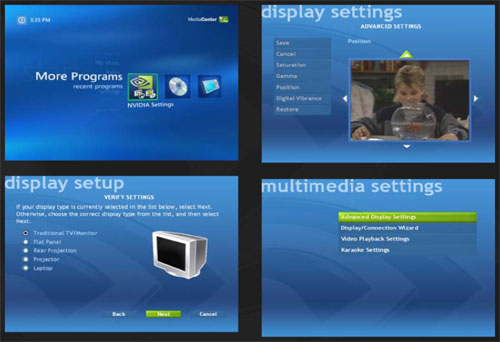
Getting Ready to Watch TV
The majority of the MCE 2005 setup process remains unchanged from previous versions, with minor tweaks here and there.
One of the most important features of the Media Center interface continues to be the ability to setup all of the Media Center options using nothing more than the remote control, which is obviously true for configuring your TV settings.
First you must confirm your region, which Media Center reads from the region your copy of Windows is set to.

Media Center 2005 has an automatic TV signal configuration wizard which works very well. It seems to have no problem detecting whether you have a cable box, direct cable or antenna. The automatic setup can even configure multiple tuners, which we will discuss shortly.

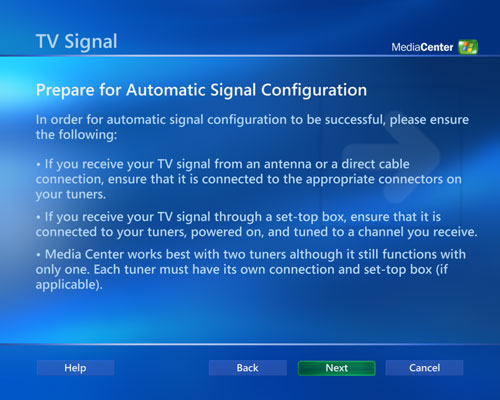
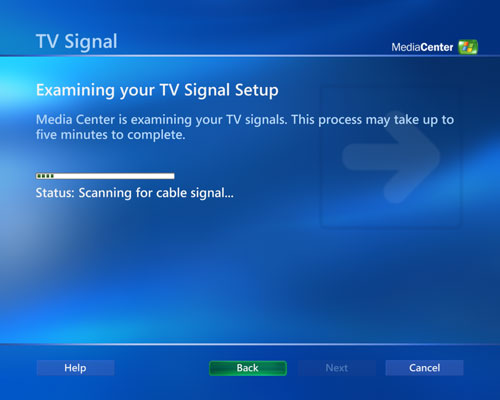
If there is any discrepancy between the automatic configuration and what you've got, you can manually configure your configuration, although we required no such intervention during our testing.

Next up after you've configured your TV signal is to setup the program guide. The Media Center program guide is one of the strongest points of MCE, considering it is the fastest and one of the most sleek interfaces available on a PVR/DVR platform. For anyone who has ever used a Tivo or ReplayTV, the speed and aesthetics of the Media Center guide itself is worth taking a look at.
The setup is pretty simple, first you've got to agree to the 58 page Terms of Service agreement. Just pressing down on the remote will scroll through each one of the 58 pages, so you'll want to hit up instead to jump directly to the I do not agree/I agree options. Don't tell us you actually read those things.
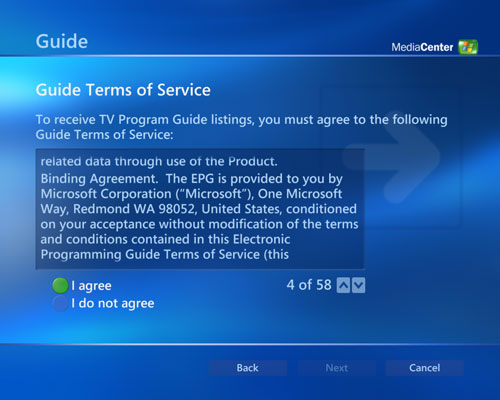
Media Center will decide what guide data to download for you based on two pieces of information: your zip code, and then by selecting your cable provider.

Once you've selected your provider, Media Center will download up to 14 days of TV listings and you'll be done with the program guide setup process. By default, Media Center will use your internet connection to keep its guide data up to date automatically, and it does a fine job of doing so.
Watching TV - Media Center gets Shortcuts
Even though it is almost two years old, the original Media Center interface still reigns as the best of the best when it comes to DVRs - set top box or PC based. The interface wasn't perfect at its release, but it was very, very close. Microsoft had done their research and the Media Center interface was quick to navigate and thanks to the power of the PC, was light years faster than any set-top PVR. With MCE2005, Microsoft took a few more steps towards perfection.
One of the biggest changes comes in the introduction of shortcuts; Microsoft has introduced a new second layer of menus referred to as shortcuts that appear as you select options in the first menu layer. Not all options have a second shortcut layer, but the ones that make sense do.
Selecting My TV for example reveals a set of three shortcuts, letting you go directly to Recorded TV, Live TV as well as a link to Movies on TV. While just scrolling to the My TV link will show its shortcuts to the right of it, hitting the right button on the remote will fade in to the shortcut menu to give you direct access to the individual items.
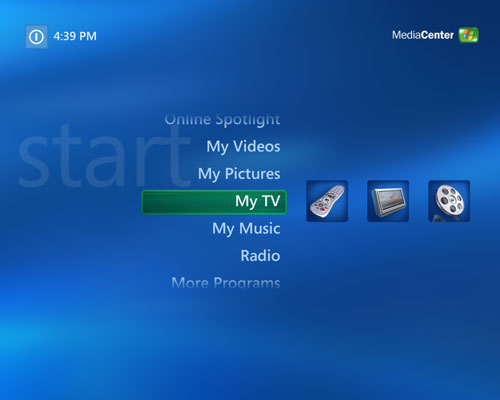
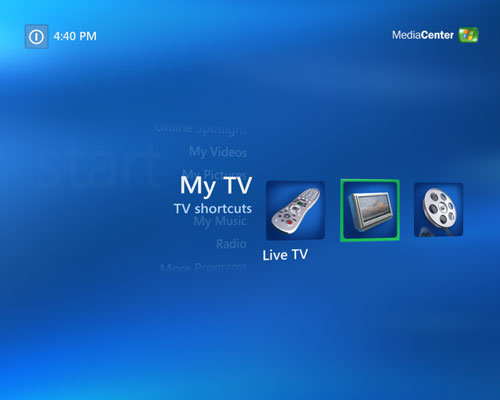
The shortcuts are pretty self explanatory; the Recorded TV link will take you to your recorded shows and live TV will let you watch TV. The Movies link will take you to a pretty neat page of all of the movies that are currently playing on TV; Media Center also pulls data from the All Movie Guide (AMG) to provide movie art, cast information and a movie review for most movies.

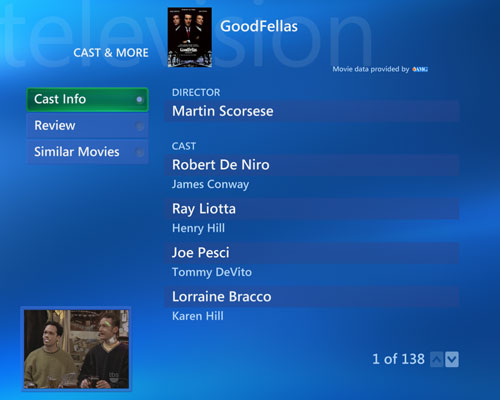

The interface is extremely easy to follow, and if you happen to have a good number of premium or movie channels on your cable lineup then the Movies link ends up being pretty useful. It's like your own Blockbuster where you rent for free. You can also get a listing of upcoming movies, which works very well for selecting what you want to record as well as what you'd like to watch.
Other menu items have shortcuts as well, such as My Music and More Programs, both of which we will get to shortly. Although they are not user definable, the introduction of shortcuts prevents the main Media Center menu from becoming scroll fest when trying to find what you want to do today.
Actually watching TV hasn't changed much. The channel information, volume controls and timescale bar have all received a slightly updated look, but their functionality remains the same.
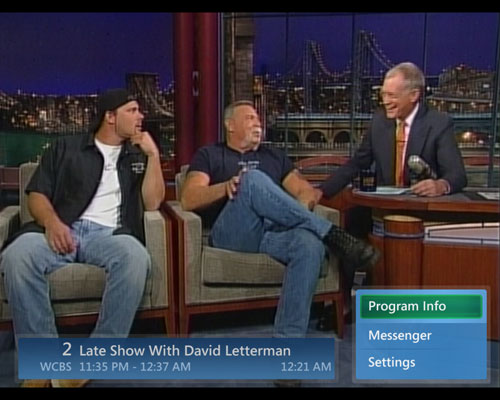
As with all PVR/DVR systems, there is a pause between switching channels as the system must start buffering before changing channels. This buffering time can be minimized with faster hardware, and what we have noticed is that the time between switching channels is indeed faster under MCE 2005 with an Athlon 64 FX-53 than with previous versions of MCE running on slower hardware. The delay is still noticeable, but it is much less dramatic as it used to be the past couple of times we've covered Media Center launches.
Program guide performance has been significantly improved since the original incarnation of MCE; while it used to be true that scrolling through the Guide would sometimes cause your video to stutter or skip, that is no longer true. MCE 2005 does a much better job of prioritizing the video encoding thread above any and all other threads running alongside it, so while your menu may not scroll as smoothly at least your video does - which is far more important.The days of dropped frames due to interacting with the GUI are long gone, even on slower machines as you will see in our performance investigation section.
For those of you that aren't familiar with Media Center's Guide, it is just as navigable as a Tivo or ReplayTV - but much, much faster thanks to the incredible processing power of a modern day x86 PC vs. the low power chips that run most set top boxes.

Maybe it's just that we're testing the Guide on faster hardware than when the original MCE and even MCE 2004 were released, but with MCE 2005 the program guide does appear to get cached much better. After scrolling through the list of channels once there are hardly any swaps to the disk, which wasn't always the case in previous versions of MCE. That being said, any sort of navigation through the GUI is extremely CPU intensive; remember that MCE is still Windows XP, and thus it's primarily a software-accelerated GUI doing some pretty fancy things that our general purpose x86 CPUs weren't necessarily designed to do.
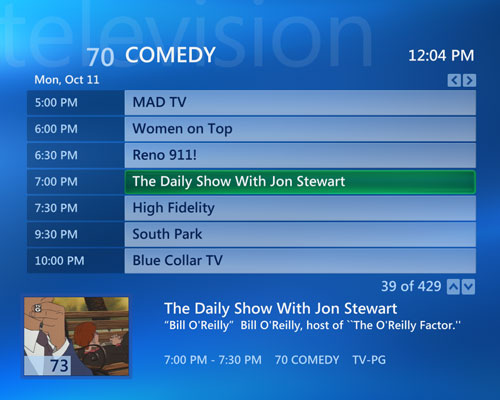
If there ever was a need for a 3D accelerated UI, Media Center would be it - offloading the interface to a GPU would make things run a lot smoother. But let's not get too ahead of ourselves, we shouldn't be wishing for MCE 2007 when we're not even done reviewing 2005.
Recording TV in 2005
Recording TV hasn't changed much with MCE 2005, although there are still some features we'd like to see. The biggest feature that's still missing is the ability to save the timeshift buffer, so if you're watching a TV show and half way through it decide that you'd like to record it, it will only start saving after you hit the record button, regardless of the fact that the rest of the show is physically on your hard drive in Media Center's buffer. It's not uncommon for a set-top PVR to lack this feature but it's a feature that ATI has had in their DVR products for a while, and something that shouldn't be too difficult for Microsoft to implement - and incredibly useful at that.
It's very easy to see what you've got scheduled to record through the Scheduled option under the Recorded TV menu.
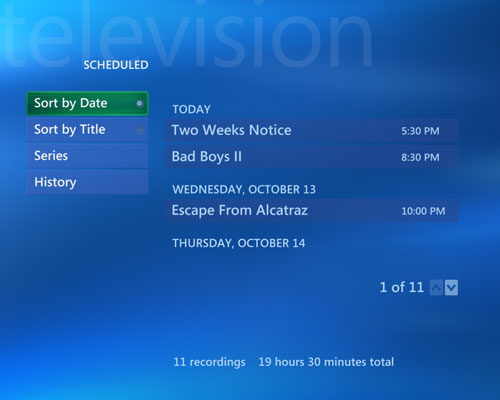
Media Center does support prioritizing of series recordings, but the settings for recording priority are buried beneath many layers of menus - My TV > Recorded TV > Scheduled > Series > Change Priorities. Once you get to the menu, it's simple to figure out how things work - the up arrows increase priority and the down arrows will decrease priority. Then in the event that there is a conflict and you're not around to manage it, Media Center will use your priorities to determine what to record and what gets the boot.
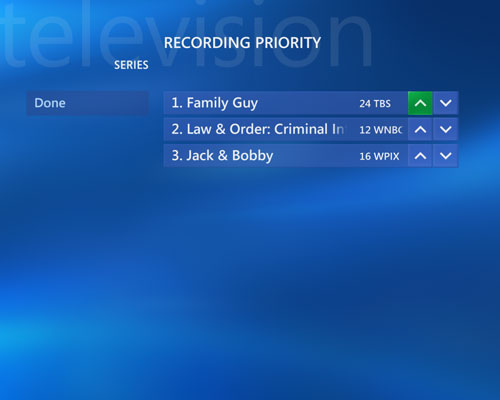
The recording settings haven't changed in 2005, using the Recorder Storage settings screen you can set MCE to record to a separate drive to improve multitasking performance.
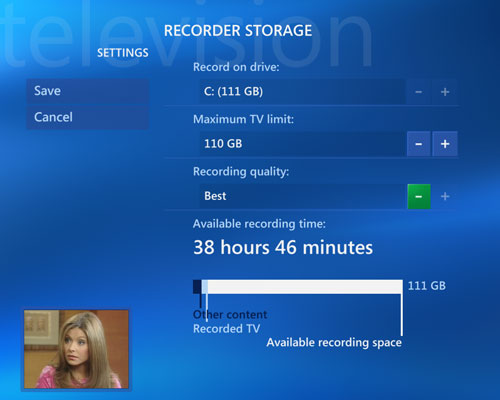
Just like in MCE 2004 you can automatically pad all recordings by starting the recording early and letting it go longer whenever possible for those pesky shows that never seem to start or end on time.

Watching Two things at Once
One of the big features of MCE 2005 is its support for up to three tuner cards. Now the tuner cards must be actually supported with MCE drivers, but you can mix and match them. The benefit of having multiple tuners is obvious: with only a single tuner if you're recording a program, you cannot change channels. With two tuners you can record one program while watching another channel and with three tuners you can record two programs while watching yet a third. Simple enough?
For our tests we used a pair of ATI eHome PCI TV tuners, which are supported under MCE 2005 with drivers from ATI.
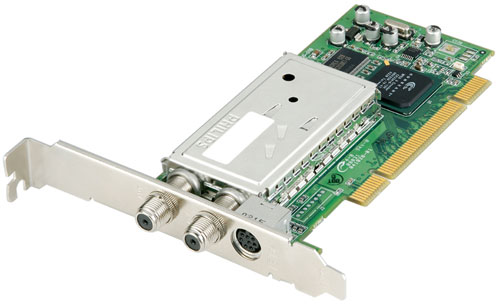
Alongside the MCE 2005 release, NVIDIA is introducing a dual-tuner single PCI card made specifically for MCE 2005 machines as a part of their NVTV tuner card line. We could not obtain a sample for this review but we will definitely keep our eyes out for one.

MCE 2005's integration and acceptance of multiple tuners is seamless. If you have multiple tuners in your system when MCE is installed, then going through the initial TV configuration wizard will allow you to select how many tuners you would like to configure. Or, if you're not big on details, you can let the configuration wizard detect that you have multiple tuners and automatically configure them for use.

If you're adding a tuner after the fact the setup is almost as simple, you need need to take one additional step. Head into the TV settings and select Set Up TV Signal from the menu; you will then be taken to the same configuration wizard you had the first time you setup the machine and you know the drill from here.
The functionality of the additional tuners is instantly activated. If you have two tuners, Media Center will no longer complain if you have two shows set to record with overlapping times. However, attempt to record a third show and the trusty conflict manager will pop up:
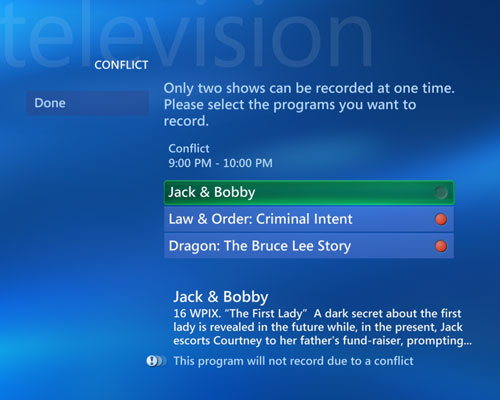
The same functionality applies to having three tuners installed, but be warned,
with three tuners you're going
to want to have a reasonably fast system.
There is no support for a picture-in-picture
mode in Media Center even with
multiple tuners installed,
so
the functionality
is
limited to
recording multiple
shows
or recording while watching.
If there were a million different ways Microsoft could have implemented multituner support in Media Center they picked the one that was most seamless to the end user; it just works.
HDTV Support
Microsoft has taken a lot of flack on this next point, and that is the support for only OTA (over the air) HDTV broadcasts. This means that the only HDTV channels MCE 2005 will support are those you can get over a HDTV antenna, not channels like HBO HD and Discovery HD. There are sensitive issues regarding content protection that pushed Microsoft in the direction of being as safe as possible with HDTV support for MCE 2005; unfortunately this is one area where Media Center truly falls behind to set-top PVRs like the new HD enabled Tivos.
In the end, with Media Center targeted at the mass consumer market, most people aren't viewing broadcasts in HD so it's not a huge loss for Microsoft, yet. We will have to wait and see how this situation plays out in the future, as it will most definitely adjust Microsoft's course of action with regards to Media Center. Needless to say, Microsoft's safe-route with MCE 2005 has pretty much sealed the verdict as to whether or not Microsoft was going to be the champion of bringing recordable HD content to the masses.
Politics and lawsuits aside, how does MCE 2005 work with OTA HDTV broadcasts? We would love to tell you, but we can't. Although ATI's HDTV Wonder is the only HD tuner supported by MCE 2005 at this time, support for HDTV isn't built into the shipping OS. Instead, there will be a patch made available after the publication of this article, that enables HDTV support but we could not get the patch from Microsoft before the publication of this article.

We will provide updated information as soon as we can get ATI's HDTV Wonder working in a quick follow-up article.
There are a few requirements that we need to spell out for OTA HDTV to work. For starters, you need at least one analog TV tuner in the MCE system, meaning that you can have at most 2 HDTV tuners it would seem. Secondly, ATI's HDTV Wonder does not feature a hardware MPEG-2 encoder, meaning that it cannot be used as both your analog and HDTV tuner, so you'll have to either wait for another card to be supported or you'll have to deal with the fact that getting OTA HDTV support will require two cards. While we haven't had a chance to test it ourselves, HDTV playback under Media Center is supposedly pretty taxing on your system and on your graphics card. We've been told that a minimum of a 128-bit graphics memory bus is necessary, but will we confirm that as soon as possible.
In the end, it's tough to list HDTV support as a feature of MCE 2005. There are far too many limitations for it to be considered a full fledged feature; but it being a "2005" edition would seemingly dictate that it at least needs to have some support for HDTV to save face among the user base.
Media Centers Everywhere with Media Center Extenders
With MCE 2005 Microsoft is also announcing two new MCE related devices: Media Center Extenders and Xbox Extenders.
The idea of a Media Center Extender is to be able to have your MCE PC in one room and watch TV, video and other content stored on it in another room, wirelessly or using your home LAN. All of those speeches about digital convergence and the future of the PC are finally upon us, Microsoft is transforming Media Center PCs into true media servers.
In November Microsoft will also be introducing another type of Media Center Extender, but this time it won't be a standalone unit, rather it will be software for the Xbox. For $79.99 MCE 2005 users will be able to use their Xbox as a Media Center Extender to make any TV in the house MCE-enabled. The Media Center Extender for Xbox package will most likely be a much cheaper version of the Media Center Extender since the hardware is already purchased in the Xbox.
Obviously the idea of Media Center Extenders works perfectly with MCE 2005's support for multiple tuners, since people in different rooms will want to watch different channels - something only made possible with multiple tuners. Take this techy dream even further and you can see how supporting only 3 tuners is a limitation, but then again our hardware isn't quite ready for that yet. The push for multicore CPUs should make a lot more sense now for the home PC; music to AMD and Intel's ears.
Portable Media Center Support
As we alluded to in our review of the new Portable Media Center devices, MCE 2005 is a much better OS for Portable Media Center owners. You no longer have to sync your device through Windows Media Player 10's interface, you can do it directly within the MCE 10-ft UI.
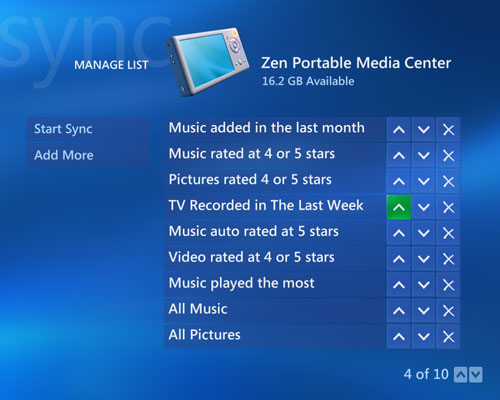
You can also background transcode your TV shows while you're watching TV, but remember that the transcoding process will eat up 100% of your CPU time, regardless of how fast your CPU is. Although MCE will prioritize properly and make sure that the live TV remains uninterrupted, your transcoding process will take longer because of it.

Those who frequently use their PMCs will definitely appreciate the MCE 2005 interface, it's worlds better and much more user friendly than Windows Media Player 10.
Music
There are other shortcut menus as well, highlight My Music and your most recently played music will appear to the right of the menu:
These tweaks as well as minor interface tweaks throughout Media Center definitely provide an even more polished experience than before. If Media Center was incredibly quick and easy to navigate before, Microsoft has made it even quicker and easier.
Media Center's My Music is basically a nice front end for your Windows Media Library, but given that Windows Media Player 10 is far from what we'd call a good UI this front end is a pleasure to work with.
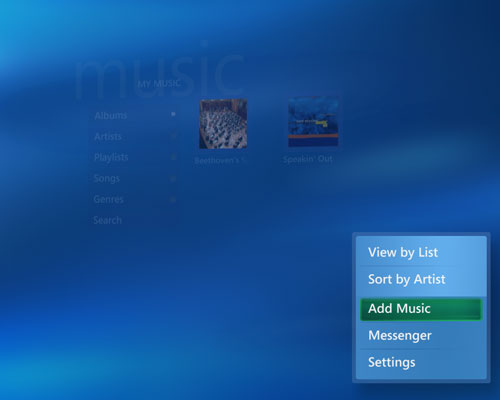
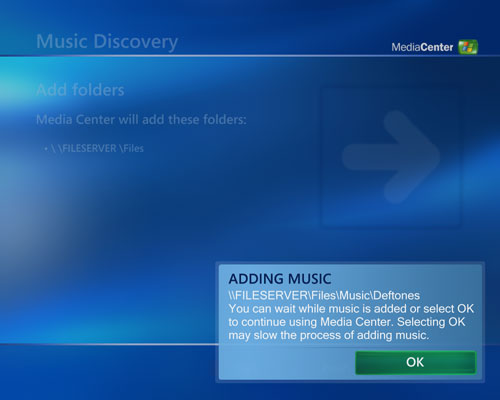
In the past there have been complaints that the performance of searching through large music libraries is basically irritatingly slow in Media Center. The performance has been improved somewhat in MCE 2005 but searching is hardly lightening fast for extremely large music collections.
With only a 3GB of MP3s in our test collection, navigating and searching for music in Media Center was extremely quick, however once you start to get much larger than that things to tend to slow down when it comes to searching for music.
Media Center once again will download album information and album arts off the net in an attempt to complete your collection and make it as pretty looking as possible. This is very similar to what we recently saw with the Portable Media Center interface, so it's no surprise to see it echoed here.
Online Spotlight
Originally introduced in MCE 2004, the Onlight Spotlight section of Media Center is a way to offer third party content to MCE PCs without breaking the Media Center interface.
While the theory is a sound one, there is a lack of quality control when it comes to the Online Spotlight experience. Not only does the interface for most of the Online Spotlight begin to look like a cheap Media Center knockoff but it's far too common to have to do something outside of the Media Center UI to complete a setup feature in one of the Online Spotlight applications.
For the most part, the Online
Spotlight applications are
just web pages
that are designed to be
viewed from within
the Media
Center
interface.
Through
the Online Spotlight you
can sign up for RSS feeds
to be
delivered to your
MCE
PC, purchase music through
Napster or even order movies
on demand.
The movies on demand features
are provided by three companies: Movielink
, CinemaNow
and interActual. Remember
that you're basically downloading these movies for a fee, so the quality
and the speed at which you download the movies are dependent on the provider
as well as your internet connection. It's obviously not as fast as cable
TV on demand services but is about on equal footing as far as quality goes in
the sense that you're not getting the highest quality video and anything
above and beyond the bare minimum 4:3 format and 2 channel audio isn't
usually provided. You're much better off recording your own movies (at
least they're free
this way) or renting a DVD.
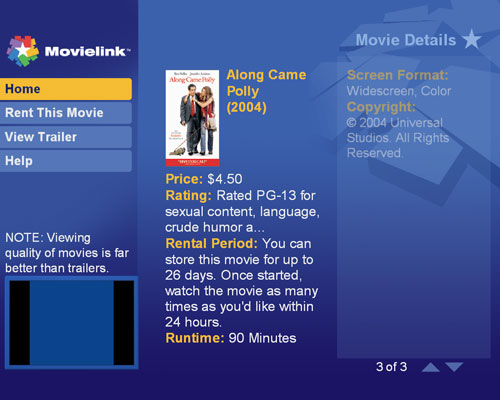
Overall the Online Spotlight section of Media Center is interesting and it definitely has promise, but the fact that just about all of the interesting features of Online Spotlight are paid subscriber features and that the entire section itself feels like you've exited Media Center and entered a much less polished program ruin the experience.
Performance
We've been wanting to have a benchmark for Media Center ever since it was released, and we do have some benchmark ideas in the works, but for today's launch of MCE 2005 we decided to take a look at what the minimum CPU requirements are for smooth operation, as well as for multituner operation.
Our testing methodology was simple; we took an Athlon 64 FX and varied its clock speed, from a lowly 1GHz all the way up to 2.6GHz. While we realize that there is no such thing as an Athlon 64 FX running at 1GHz, running it at such a low speed does a couple of things for us: for starters, it reduces the benefit of having an on-die memory controller, the slower a CPU is, the less it depends on having low latency memory accesses. Another important feature that our little experiment gives us is that architecturally, the Athlon 64 is quite similar to the Athlon XP; there are some enhancements to areas such as brand prediction and a corresponding lengthening of the pipe, but overall our system at 1GHz should be a good indicator of slower 1.2 - 1.5GHz CPUs, whether we're talking about an Athlon XP or even a Pentium 4. It's not perfect, but it serves our goals well.
There are a couple of performance questions we've been dying to ask ever since Media Center Edition hit the streets back in 2003, the first of which was have fast does your CPU have to be to watch TV?
We fired up perfmon and measured CPU utilization while varying the clock speed (AMD's Cool 'n Quiet technology was disabled to make this as scientific of a comparison as possible) and came up with some interesting results.
Despite the fact that we were using "hardware" MPEG-2 encoders, the CPU overhead of just watching TV ranged from 21.5% on our fastest configuration to a whopping 42.9% on our slowest configuration. And this is just for watching TV in the Media Center interface. Try scrolling through the program guide and you can expect to tack on anywhere from 10 - 40% onto those CPU utilization figures; try running an application in the background while doing that and you can begin to see why a fast CPU is necessary.
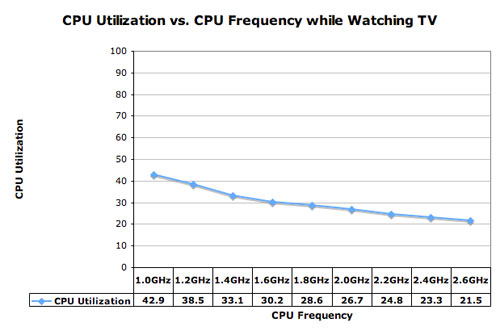
Keep in mind that most 1GHz CPUs won't do nearly as well as our configuration, so expect even higher CPU utilization figures for older architectures. But all that being said, if all you're doing is watching TV, even the slowest of our configurations here had no problem doing that - which they shouldn't, in all honesty. It's when you complicate the situation with multiple recordings and interacting with the GUI that things get interesting. So for our next tests, we spiced things up a bit.
Multituner Performance
For our next test we wanted to see how much more overhead adding a second tuner card and recording two programs would cost us. We recorded a show in the background while watching another TV show, once again all while varying CPU clock speed over time - the rest of our testbed remained the same.
We left the results from only a single tuner on the same graph to see the extra penalty incurred by going to dual tuners. As you can see, you basically add on another 10% CPU usage for recording one program while watching another. You can extrapolate that to get an idea of what kind of hardware you'd need for 3 tuners.

But once again, even in the worst configuration we're still only looking at 54% CPU usage, that's more than enough to spare. But what happens when you start scrolling through the program guide for something else to watch when you're sick of one of your programs?
We continued our experiment by scrolling through the program guide while recording one program and while we had another show running in its window in the corner of the guide. Here the average CPU utilization increases dramatically, with everything slower than 2GHz racking up over 90% CPU utilization.
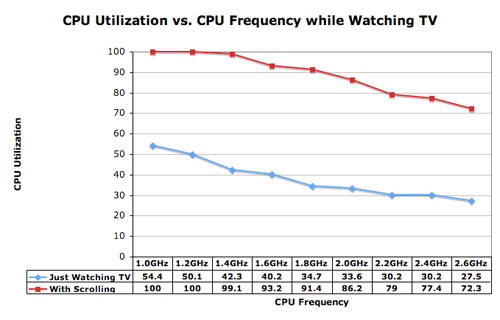
Once you get closer to 100% CPU utilization that's when things start to get choppy and we saw some serious reductions in smoothness on our lower end configurations. Interestingly enough, even in our choppiest configuration the MCE system was still more responsive and faster navigating through the guide than a Tivo. What we lost was the smooth transitions from one page in the guide to the next, or from one listing to the next, everything was a lot more jerky.
The plot thickens when you look at maximum CPU utilization during the time period, while the three fastest CPUs had their average utilizations in the 70s, their peak CPU usage figures were in the 80s and 90s, bordering on 100% CPU utilization. Whenever we hit 100%, something had to give, but luckily it was always the speed of the menu, never the frames in the video - something we were very appreciative of.
Another interesting phenomenon we noticed was that the slower the system got, the more prone it was to crashes. The larger the processing and disk queues got, the more our custom built Socket-939 testbed with aggressive memory timings started to crash. The majority of the crashes were hard locks and they didn't happen at all with the faster CPU configurations, but they definitely happened once we dropped below 1.6GHz.
The Final Test
The only way Microsoft can justify the price of a Media Center PC is by offering it as a multipurpose machine, as a Media Center PC as well as your regular family, office, gaming or whatever-else-you-do-with-it PC. The problem with this scenario is, as we just established, that Media Center takes up quite a bit of horsepower when you're using it as intended. So how usable are these machines as multitaskers between recording TV shows and doing everything else you do with your PC?

Anytime you switch between the Media Center interface and the XP interface, the entire system pauses - video, audio, everything. The pause is annoying and will sometimes interrupt whatever it is you may be recording; this pause is present regardless of how fast or how slow your CPU is; it will occur when going from a full screen Media Center interface to a windowed one, or when simply minimizing the Media Center interface.
Luckily for Microsoft, most users don't run through the program guide while typing in Word or watch TV while they're gaming. Most of the time the Media Center interface will actually be closed while the user is doing something else with their PC. Microsoft understood this and thus allowed Media Center to continue to record scheduled shows even while the interface was inactive. Which leads us to our next question, how much overhead is there when the Media Center interface isn't running, but the system is still recording a show?
When you're just watching TV on a MCE box, quite a bit is happening on the inside, keeping your entire system busier than most people probably ever tax their machines. The video present on your screen is being encoded and decoded in real time in front of you, which is the cause for most of the high CPU utilization that you get when just "watching TV." But if you aren't watching the TV, just recording what's on a particular channel, then you're only encoding the data that comes into the TV tuner, there's no decoding done - so less of your CPU is used. How much less? Quite a bit.
While our fastest platform had about 21% of its CPU power in use while watching TV, only 6.5% of its time was used when simply recording a show in the background. While that's more CPU power than playing an MP3, it still leaves quite a bit for you to complete other tasks. Even the mid-range configurations only had about 10% of their CPU power tied up, leaving the system very free to do many other things.

There is one limitation to keep in mind here however. While we see that recording a single show without displaying it on the screen at the same time does not require much CPU power, thanks to the hardware-assisted encoding of ATI's eHome Wonder card, don't forget that all of this recording is giving your hard drive a good workout. We tried launching MS Paint while recording just a single show, and a normal instantaneous program startup was instead replaced with a 5 second program startup, all thanks to the single hard drive in our test bed. The way around this problem is to have a second drive, and to have Media Center record all of its programming to a hard drive separate from the one the rest of your applications are on.; this is a necessity if you plan on using your MCE machine as a regular PC while it goes about its Media Center duties. Through the recorder settings you can tell Media Center to store its buffer and recorded shows on a separate hard drive; problem solved.
Next we wanted to see how much of an increase in CPU utilization there was by recording two shows simultaneously, once again, outside of the Media Center interface.
Here we see that the performance hit isn't too bad until we get much slower than 1.6GHz, but even then it's not horrible.

With over 80% of your CPU going unused, that's plenty of horsepower to work on documents, surf the web and even play a few games. With the right processor, MCE 2005 can definitely be used as the all purpose PC that Microsoft wants it to be. The thing to keep in mind is that the stability of the system will definitely be pushed to the limits; running MCE has shown us that poorly written drivers, overly aggressive memory timings and general hardware instability definitely won't cut it under this type of load.
Final Words
Media Center Edition continues to be the coolest looking highest performance PVR/DVR (with a fast enough system) out there on the market today. The interface continues to be clearly ahead of the competition even with companies like SnapStream closing in on them. The navigation through the beautiful 10' UI is as natural as you can get; the learning curve on the Media Center interface is probably the easiest there has ever been in any Microsoft OS, which is extremely important for success in the consumer space. From a product standpoint, Microsoft has built the foundation for perfection with Media Center Edition, and the 2005 version simply adds a 2nd floor to the building.
The problems with Media Center Edition continue to be the same ones that have plagued it all of its short lived life: 1) cost, and 2) stability.
The cost issue is simple, a PC costs far more than a set top PVR like a Tivo. The only way to justify the cost is to do what most businesses do when they buy something expensive, use it for as many things as possible to get your money's worth. In the case of a Media Center PC, the idea would be to use the Media Center PC not only as your PVR but also as your main computer. There are problems with this arrangement, not only that you need a fairly high performance system but also that you can't have someone watching TV while you're using the computer to do work without the use of a Media Center Extender, which is another expenditure.
The Media Center PC continues to thus be a good proposition for college students or other people living in closed quarters where there isn't enough room for a TV alongside a PC. It will be interesting to see how well Media Center Extenders are priced, as they will finally allow for the MCE PC to break out of the dorm room and into the home.
The stability issue is one that can be controlled to an extent, but is much more difficult to control if the MCE PC is also being used as an everyday work/school/play PC. The best bet is to control the stability as much as possible through the use of MCE certified drivers, MCE certified hardware, and avoiding things like aggressive memory timings and most definitely overclocking. While your system may be perfectly stable in every other application, MCE changes the playing field considerably.
In the end, MCE continues to be a niche product, but if you have the means, then its definitely one worth going for.

